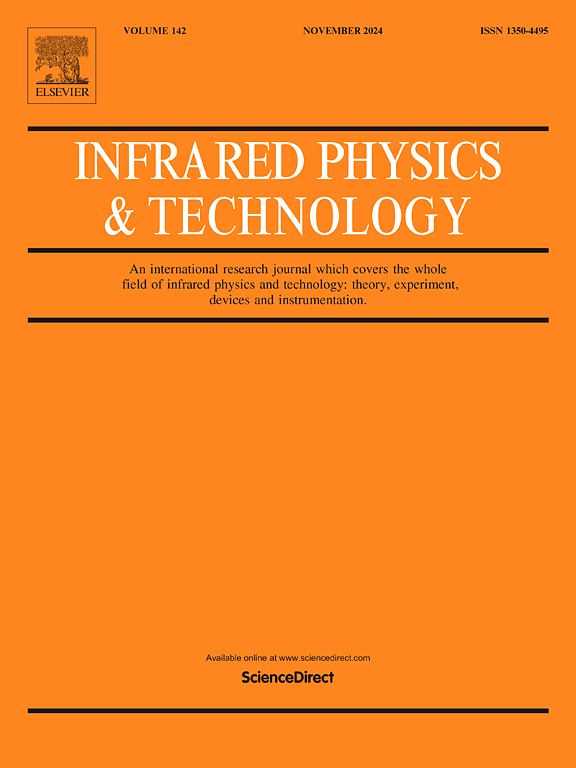PoLP-ICOP:线性偏振功率与基于红外cri的最优偏振在人工目标检测中的交叉验证
IF 3.1
3区 物理与天体物理
Q2 INSTRUMENTS & INSTRUMENTATION
引用次数: 0
摘要
对自然背景下的人造物体进行检测,减少对长波红外的误检,对安全与安防应用具有重要意义。线性偏振度(DoLP)是解决这类问题的常用方法。DoLP可以为人造对象签名提供重要线索。另一方面,由于归一化,DoLP无法处理极化功率。首先,提出了一种新的物理驱动的线性极化功率度量,用于解析地寻找最优红外极化条件。其次,提出了一种数据驱动的红外偏振方法。在低水平上进行的极化优化研究很少。本文提出了一种新的极化信息利用方法,利用具有反比辐射强度(CRI)损失函数的双层神经网络来寻找物理意义。提出了一种基于红外合成孔径(cri)的最优偏振法(ICOP),该方法可以提取每个偏振图像在自然背景下识别人造物体时的低水平贡献。优化后的极化图像的学习权值是正弦的,得到了最优的目标和背景分离。室外场景的实验结果验证了该方法在自然背景下人工目标检测中的最优性。最后,物理驱动的PoLP与数据驱动的ICOP在人造物体探测中是一致的。本文章由计算机程序翻译,如有差异,请以英文原文为准。

PoLP-ICOP: Cross-validation of Power of Linear Polarization and Infrared CRI-based Optimal Polarization for artificial object detection
It is important to detect man-made objects in a natural background to reduce false detections in long-wave infrared for safety and security applications. The degree of linear polarization (DoLP) is used frequently to solve such problems. DoLP can provide important clues for man-made object signatures. On the other hand, DoLP cannot handle the polarization power because of normalization. First, a novel physics-driven power of linear polarization (PoLP) metric is proposed to find optimal infrared polarization conditions analytically. Second, a data-driven infrared polarization method is presented. Few studies have been conducted in terms of polarimetric optimization at a low level. This paper presents a novel polarimetric information utilization method by applying a two-layered neural network with the inverse contrast radiant intensity (CRI) loss function to find physical meaning. The proposed infrared CRI-based optimal polarimetry (ICOP) could extract the low-level contribution of each polarimetric image in discriminating artificial objects in a natural background. After optimization, the learned weights of the polarimetric images were sine-like, which produced optimal object and background separation. The experimental results for the outdoor scenario validated the optimality of the proposed ICOP in man-made object detection in a natural background. Finally, the physics-driven PoLP coincided with the data-driven ICOP in man-made object detection.
求助全文
通过发布文献求助,成功后即可免费获取论文全文。
去求助
来源期刊
CiteScore
5.70
自引率
12.10%
发文量
400
审稿时长
67 days
期刊介绍:
The Journal covers the entire field of infrared physics and technology: theory, experiment, application, devices and instrumentation. Infrared'' is defined as covering the near, mid and far infrared (terahertz) regions from 0.75um (750nm) to 1mm (300GHz.) Submissions in the 300GHz to 100GHz region may be accepted at the editors discretion if their content is relevant to shorter wavelengths. Submissions must be primarily concerned with and directly relevant to this spectral region.
Its core topics can be summarized as the generation, propagation and detection, of infrared radiation; the associated optics, materials and devices; and its use in all fields of science, industry, engineering and medicine.
Infrared techniques occur in many different fields, notably spectroscopy and interferometry; material characterization and processing; atmospheric physics, astronomy and space research. Scientific aspects include lasers, quantum optics, quantum electronics, image processing and semiconductor physics. Some important applications are medical diagnostics and treatment, industrial inspection and environmental monitoring.

 求助内容:
求助内容: 应助结果提醒方式:
应助结果提醒方式:


